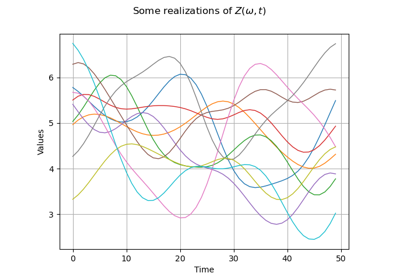ValueFunction¶
- class ValueFunction(*args)¶
Function mapping a field to a field.
Notes
Value functions act on fields to produce fields such that:
with
,
and
a mesh of
.
A value function keeps the mesh unchanged: the input mesh is equal to the output mesh.
The field
is defined by the function
:
The first constructor builds an object which evaluation operator is not defined (it throws a NotYetImplementedException). The instanciation of such an object is used to extract an actual
ValueFunctionfrom aStudy.Examples
>>> import openturns as ot
Create the function
defined by:
>>> g = ot.SymbolicFunction('x', 'x^2')
Convert
into a value function with
the dimension of the mesh of the field on which
will be applied:
>>> n = 1 >>> tg = ot.RegularGrid(0.0, 0.2, 6) >>> myValueFunction = ot.ValueFunction(g, tg) >>> # Create a TimeSeries >>> data = ot.Sample(tg.getN(), g.getInputDimension()) >>> for i in range(data.getSize()): ... for j in range(data.getDimension()): ... data[i, j] = i * data.getDimension() + j >>> ts = ot.TimeSeries(tg, data) >>> print(ts) [ t v0 ] 0 : [ 0 0 ] 1 : [ 0.2 1 ] 2 : [ 0.4 2 ] 3 : [ 0.6 3 ] 4 : [ 0.8 4 ] 5 : [ 1 5 ] >>> print(myValueFunction(ts)) [ y0 ] 0 : [ 0 ] 1 : [ 1 ] 2 : [ 4 ] 3 : [ 9 ] 4 : [ 16 ] 5 : [ 25 ]
Methods
__call__(*args)Call self as a function.
Get the number of calls of the function.
Accessor to the object's name.
Get the function
.
getId()Accessor to the object's id.
Get the description of the input field values.
Get the dimension of the input field values.
Get the mesh associated to the input domain.
getMarginal(*args)Get the marginal(s) at given indice(s).
getName()Accessor to the object's name.
Get the description of the output field values.
Get the dimension of the output field values.
Get the mesh associated to the output domain.
Accessor to the object's shadowed id.
Accessor to the object's visibility state.
hasName()Test if the object is named.
Test if the object has a distinguishable name.
Whether the function acts point-wise.
setInputDescription(inputDescription)Set the description of the input field values.
setInputMesh(inputMesh)Set the mesh associated to the input domain.
setName(name)Accessor to the object's name.
setOutputDescription(outputDescription)Set the description of the output field values.
setOutputMesh(outputMesh)Set the mesh associated to the output domain.
setShadowedId(id)Accessor to the object's shadowed id.
setVisibility(visible)Accessor to the object's visibility state.
- __init__(*args)¶
- getCallsNumber()¶
Get the number of calls of the function.
- Returns:
- callsNumberint
Counts the number of times the function has been called since its creation.
- getClassName()¶
Accessor to the object’s name.
- Returns:
- class_namestr
The object class name (object.__class__.__name__).
- getFunction()¶
Get the function
.
- Returns:
- g
Function Function
.
- g
Examples
>>> import openturns as ot >>> g = ot.SymbolicFunction('x', 'x^2') >>> n = 1 >>> mesh = ot.Mesh(n) >>> myValueFunction = ot.ValueFunction(g, mesh) >>> print(myValueFunction.getFunction()) [x]->[x^2]
- getId()¶
Accessor to the object’s id.
- Returns:
- idint
Internal unique identifier.
- getInputDescription()¶
Get the description of the input field values.
- Returns:
- inputDescription
Description Description of the input field values.
- inputDescription
- getInputDimension()¶
Get the dimension of the input field values.
- Returns:
- dint
Dimension
of the input field values.
- getMarginal(*args)¶
Get the marginal(s) at given indice(s).
- Parameters:
- iint or list of ints,
Indice(s) of the marginal(s) to be extracted.
- iint or list of ints,
- Returns:
- function
ValueFunction The initial function restricted to the concerned marginal(s) at the indice(s)
.
- function
- getName()¶
Accessor to the object’s name.
- Returns:
- namestr
The name of the object.
- getOutputDescription()¶
Get the description of the output field values.
- Returns:
- outputDescription
Description Description of the output field values.
- outputDescription
- getOutputDimension()¶
Get the dimension of the output field values.
- Returns:
- d’int
Dimension
of the output field values.
- getOutputMesh()¶
Get the mesh associated to the output domain.
- Returns:
- outputMesh
Mesh The output mesh
.
- outputMesh
- getShadowedId()¶
Accessor to the object’s shadowed id.
- Returns:
- idint
Internal unique identifier.
- getVisibility()¶
Accessor to the object’s visibility state.
- Returns:
- visiblebool
Visibility flag.
- hasName()¶
Test if the object is named.
- Returns:
- hasNamebool
True if the name is not empty.
- hasVisibleName()¶
Test if the object has a distinguishable name.
- Returns:
- hasVisibleNamebool
True if the name is not empty and not the default one.
- isActingPointwise()¶
Whether the function acts point-wise.
- Returns:
- pointWisebool
Returns true if the function evaluation at each vertex depends only on the vertex or the value at the vertex.
- setInputDescription(inputDescription)¶
Set the description of the input field values.
- Parameters:
- inputDescriptionsequence of str
Description of the input field values.
- setInputMesh(inputMesh)¶
Set the mesh associated to the input domain.
- Parameters:
- inputMesh
Mesh The input mesh
.
- inputMesh
- setName(name)¶
Accessor to the object’s name.
- Parameters:
- namestr
The name of the object.
- setOutputDescription(outputDescription)¶
Set the description of the output field values.
- Parameters:
- outputDescriptionsequence of str
Describes the outputs of the output field values.
- setOutputMesh(outputMesh)¶
Set the mesh associated to the output domain.
- Parameters:
- outputMesh
Mesh The output mesh
.
- outputMesh
- setShadowedId(id)¶
Accessor to the object’s shadowed id.
- Parameters:
- idint
Internal unique identifier.
- setVisibility(visible)¶
Accessor to the object’s visibility state.
- Parameters:
- visiblebool
Visibility flag.
Examples using the class¶

Create a process from random vectors and processes
 OpenTURNS
OpenTURNS

